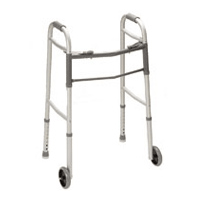Walkers, Rollators and other walking equipment have two purposes. To help in rehabilitating injured users and to allow users with permanent disabilities the ability to move without aid. With or without wheels, walkers and rollators will give users more freedom.
Walkers with & without Wheels
This is the standard walker you see everyday. Built with telescoping aluminum supports, the standard walker is a great way for individuals with injuries or disabilities to get around. Better support than a rollator.
Rollators (Rolling Walkers)
A rollator is basically a standard walker with tires attached. Unlike a regular walker, a rollator doesn’t involve the lift that a normal walker requires. Makes walking a smoother process. A rollator however requires that the user be stable enough to not let it get away from them since it has wheels.
Knee Walker – Kneeling Rolling Walker
Knee walkers can be utilized by individuals that have an injury in one leg. They are a perfect alternative to crutches and allow an individual to move without pain or difficulty.
Choosing a Walker or Rollator
Before purchasing a walker, rollator, or other walking aid be sure to keep these considerations in mind.
Height of the user – If the walking aid is too low, it will encourage bad posture. Make sure to purchase with this in mind. Many walking aids have the ability to adjust for height considerations.
Weight of the user – If the walking aid can’t support the user than it is virtually useless. Make sure to verify the maximum weight capacity.
Handgrips – Most walking aids have either molded plastic or foam rubber handgrips. Some handgrips can be adjusted to the users preference. There are also options in handgrips that are specifically designed to spread weight over a wider area of the palm.
3 Legged Frames – Three leg frames allow for greater maneuverability but are less stable than 4 legged frames. Great for getting through smaller spaces.
4 Legged Frames – Four leg frames are more stable allowing the user to maneuver through tougher terrain. Since they are bulkier, they may not be good for tight spaces. Good for individuals that go outside.
Wheels (for rollators) – The wheels of your rollator can be large or small. The larger they are the easier it is to get over tougher obstacles. Smaller wheels are more suited for indoor use. Wheels can also be fixed or have a swivel.
Brakes (for rollators) – There are three types of breaks in a rollator. Pressure, cable, and locking. They all have good points and bad. Make sure to ask your supplier for information on the strengths and weaknesses of each type.
Indoor vs Outdoor – Two walkers may be the answer. A rollator for outdoor use and a standard walker for indoor. If you have separate levels to your house or apartment you may also consider getting one for each flour.
The key to better mobility and safety is correctly matching the walking aid to the user’s needs, abilities, limitations, and environment.









